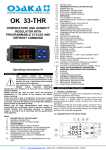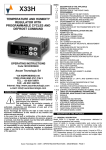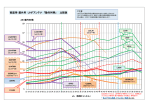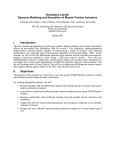Download PyPES Library Manual
Transcript
PyPES Library Manual Marat Sibaev, Deborah Crittenden∗ May, 2015 Contents 1 Introduction 2 2 Setup and usage 3 3 Input options 5 4 Tutorials ∗ 20 Department of Chemistry, University of Canterbury, Christchurch, NZ 1 1 Introduction For those interested in an overview of what PyPES library is about and how it works, please refer to the original publication. [1] A pre-print version is included in the distribution documentation for convenience, together with a .csv file containing our VCI results for all force-fields. This manual contains a list of all input commands, along with a list of implemented force-fields, and a few small tutorials on how to utilise different features of the program. The tutorials are also included in the PyPES release within the tutes/ directory. The code is released for everyones use, freely. You are welcome to use the code as you please, and incorporate parts of it into your own programs. However, we do ask that you give credit where it’s due and please cite the original paper if you find this work useful in your research. If you find any bugs in our implementation, please send the input file with description of the error to [email protected]. 2 2 Setup and usage PyPES requires the following programs and packages to be properly installed and configured: • Python 2.7+ or Python 3.0+ • SciPy 0.13.2+ • NumPy 1.8.0+ • SymPy 0.7.4.1+ • Cython 0.21+ PyPES has been tested with Python 2.7.6 and 3.4.1, with the packages listed above. PyPES should be compatible with more recent versions of the listed programs and packages, and is also probably backward compatible within major versions. We strongly recommend using a package manager (MacPorts, HomeBrew, etc) to install the required Python and Cython distributions. After downloading the compressed and zipped PyPES.tgz file, it should be moved to an appropriate install directory and extracted: tar xvfz PyPES.tgz The next step is to compile the computationally intensive modules that have been optimized and converted to C code using the Cython package. This is most easily achieved using a Cython install and the provided setup_cyth.py script: cd PyPES/code make_clean python setup_cyth.py build_ext --inplace The C modules may also be compiled using a standard C compiler (see Cython project website for details) but this is not recommended. Once the C modules have been compiled and the correct paths added to your system, the format for calling PyPES is: pypes_lib.py input_file (output_file) 3 where formats for input_file and output_file are explained in the tutorials. Specifying the output_file is optional and can be ignored if you are only interested in obtaining derivative data written to separate files. For those interested in calling PyPES from their code, as they would an ab-initio package, wrappers are included in the code/wrappers directory. Atomic units are used within the program and all output data is in atomic units as well. Conversion constants can be found in constants.py. 4 3 Input options Before describing the PyPES input options, we first define terminology used to describe coordinate systems implemented within PyPES (Table 1), and special characters used within the input file (Table 2). Table 1: Summary of internal coordinates that have been implemented. See original paper for definitions. BL = bond length, BA = bend angle, DA = dihedral angle, OOP = out-of-plane coordinate, SPF = Simons-Parr-Finlan radial coordinate, CH = Carter-Handy bend angle coordinate. Symbol Usable name Symbol Usable name r BL τ DA fM (r) Morse sin(τ ) SinDA fSPF (r) SPF ω OOP1 θ BA sin(ω) SinOOP1 cos(θ) CosBA ω0 OOP2 fCH (θ) CH sin(ω 0 ) SinOOP2 Table 2: Special characters that can be used in input_file. Character Description # line is ignored, when used as a first character on that line; ; can be used to wrap the line; STOP stops reading commands; @@@ indicates end of job-block. 5 Command Options / Default / Description COMMENT "your comment, use semicolon ; to wrap the line" Default: None Specified comment must be enclosed in quotation marks. MOLECULE name Default: None A valid name must be specified to determine which force-field module to load. Names of implemented force fields are given in Table 4. Multiple names separated by empty space indicate multiple jobs per input block. PESN integer ≥ 1 Default: 1 6 Specifies which force-field within the module to use. Valid potential energy surface numbers for each molecule are listed in Table 4 DLVL_INT -1 to 6 Default: 0 Derivative level for derivatives of PES with respect to internal coordinates, and coordinate system in which force field is defined (see tutorial 4). -1 – no derivatives are calculated (useful if only geometry optimisation is required); 0 – energy is calculated (zeroth derivative); 1 – first derivative; etc. DLVL_CART 0 to 6 Default: max(0, DLVL_INT) Continued on next page Table 3 – Continued from previous page Command Options / Default / Description Derivative level for derivatives of PES with respect to Cartesian and normal mode coordinates, generated through coordinate transformation. PRINT_DERIV_INT True or False Default: True Prints derivatives of PES with respect to internal coordinates, to the output_file if given, or to separate data files if PRINT_DERIV_FILE is set explicitly, or both. PRINT_DERIV_CART True or False Default: False Prints derivatives of PES with respect to Cartesian coordinates, to the output_file if given, or to separate data files if PRINT_DERIV_FILE is set explicitly, or both. 7 PRINT_DERIV_NM True or False Default: True Prints derivatives of PES with respect to normal mode coordinates, to the output_file if given, or to separate data files if PRINT_DERIV_FILE is set explicitly, or both. PRINT_DERIV_FILE file_name Default: None If file_name == "default", then file_name = "derivs_" + MOLECULE + "_" + PESN Writes derivatives into separate files for each derivative level (suffixed with _DnV where n = derivative level). Only derivatives set using PRINT_DERIV commands above will be written. Upper triangular matrix elements (1 ≤ i ≤ nvar; i ≤ j ≤ nvar; etc) are printed line by line, and wrapper scripts for restoring the derivative matrices in Python, C, FORTRAN, MATLAB and Mathematica are included with the program. Continued on next page Table 3 – Continued from previous page Command Options / Default / Description To distinguish between derivatives with respect to different coordinates, extensions are added to the file names: .d_int, .d_cart and .d_nm for internal, Cartesian and normal mode coordinates, respectively. MASSES None Default: as stored in the force-field module Indicates that new masses are specified. New masses may be specified within the MASSES section in one of two ways (see also Tutorial 2) MASSES atom_index mass in a.m.u. or atom_index new_atom_type END 8 Both specification formats may be used within a single MASSES section, and MASSES takes precedence over atom types assigned in CARTESIAN Available atom types within PyPES correspond to common atomic isotopes, with the isotope number specified after the element label, e.g. 1 H = H1, 2 H = H2, etc. Unnumbered atom labels correspond to most common isotope of each element e.g. 1 H = H1 = H. CARTESIAN bohr or angstrom Default: unit = bohr, equilibrium geometry loaded from force field module for MOLECULE User-specified geometries must be in the following format (see Tute 2): Cartesian bohr/angstrom atom_type X Y Z . . . Continued on next page Table 3 – Continued from previous page Command Options / Default / Description Available atom types within PyPES correspond to common atomic isotopes, with the isotope number specified after the element label, e.g. 1 H = H1, 2 H = H2, etc. Unnumbered atom labels correspond to most common isotope of each element e.g. 1 H = H1 = H. The order and identity of atoms must be the same as in the saved force-field (also given in Table 4), but isotopic substitutions are allowed using the isotope numbering convention described above. INTERNAL bohr or angstrom Default: unit = bohr, equilibrium geometry Indicates that new geometry in internal coordinates is specified, in the following format (see Tute 2): INTERNAL bohr/angstrom i_int value . . . 9 END where i_int is internal coordinate index number and value its desired value. The geometry must be specified with respect to the {r,θ,τ ,ω or ω 0 } coordinate system, i.e. even if a forcefield is defined in terms of {fM (r), cos(θ), sin(τ )} coordinates, the specified value must correspond to {r,θ,τ } coordinates. All angular coordinates must be specified in degrees. The corresponding geometry in Cartesian coordinates is obtained by minimising root-mean-square-deviation from specified internal coordinates. If CARTESIAN is specified concurrently, then the given Cartesian geometry is used as a starting point. Otherwise, the equilibrium geometry is used. OPT_GEOM_WRT_E True or False Default: False Optimises geometry with respect to energy, using the minimize() function from SciPy. MASSES_FILE file_name Continued on next page Table 3 – Continued from previous page Command Options / Default / Description Default: None File specifying masses, should contain MASSES section in format described above. No special characters or empty lines are allowed. Takes precedence over MASSES in input_file. COORDS_CART_FILE file_name Default: None File specifying geometry in Cartesian coordinates, should contain CARTESIAN command in format described above. No special characters or empty lines are allowed. Takes precedence over CARTESIAN in input_file. COORDS_INT_FILE file_name Default: None File specifying geometry in internal coordinates, should contain INTERNAL command in format described above. 10 No special characters or empty lines are allowed. Takes precedence over INTERNAL in input_file. DO_NORMAL_MODE True or False Default: False, unless PRINT_DERIV_NM = True Performs normal mode analysis. Requires at least second derivatives of PES with respect to Cartesian coordinates to be calculated. Harmonic frequencies will be printed before and after projection of rotational and translational degrees of freedom, together with Cartesian vectors defining normal mode coordinates ( ∂X coeffi∂Q cients). Warning: Normal mode coordinates are only defined at equilibrium, it is not valid to perform normal mode analysis off equilibrium. If requesting normal mode derivatives at an off-equilibrium geometry it is your responsibility to provide valid normal mode coordinate vectors calculated at equilibrium, via the NEW_NM_COORDS keyword. NEW_NM_COORDS file_name Default: None Continued on next page Table 3 – Continued from previous page Command Options / Default / Description Reads in new set of normal mode coordinates, ∂X , ∂Q from file_name and transforms derivatives of PES with respect to Cartesians to the derivatives with respect to the supplied coordinates. It is easiest to obtain ∂X | ∂Q eq from a previous PyPES calculation at equilibrium, see Tute 3. NEW_INT_TYPE 1a) i_int/new_int_type ; identify internal by its index and specify its new internal type (e.g. 2/SinDA) 1b) i_int/new_int_type/int_params ; same as 1a) only add necessary internal parameters (e.g. 5/Morse/1.0) 2) old_int_type/new_int_type ; change all internal coordinates of type old_int_type to type new_int_type, internal parameters cannot be specified (e.g. Morse/SPF) Default: None Important note: No spaces are allowed between type specifiers and forward slash characters, the whole argument must be one continuous string. Transforms derivatives of PES with respect to one set of internal coordinates, into a new set of internal co- 11 ordinates. Valid int_types are given in Table 1, int_params are used in defining parameterized coordinates (Morse, Carter-Handy). When transforming into Morse or Carter-Handy coordinates internal parameters can only be specified using option 1b), otherwise they will be calculated automatically, using α= 2 ∂3V /(3 ∂∂rV2 ) ∂r3 for Morse parameter and; β1 = 1.0, β2 = 2 ∂3V /(6 ∂∂θV2 ), ∂θ3 β3 = −[β1 + 2β2 (π − θeq )]/[3(π − θeq )2 ] for Carter-Handy parameters. 3 This formulation ensures that 3rd derivatives( ∂∂SV3 ) are zero in the new coordinates, and for Carter-Handy coordinates, 1st derivatives of CH with respect to Cartesians are zero when the bend angle is linear ( ∂(CH) | = 0). ∂X θ=π Warning: You need to set DLVL_INT ≥ 3, and this procedure should only be used to estimate required parameters for a given molecule at equilibrium. Thereafter, the same parameters should be supplied explicitly for each coordinate. Continued on next page Table 3 – Continued from previous page Command Options / Default / Description This procedure has been found to work well for the Morse parameter, [2] but hasn’t been tested for the CarterHandy coordinate. In either case, it is important to double check that coordinates are sensible after transforming. Also, transformation between internals of the same type is allowed, e.g. if internal number 5 is Morse then 5/Morse/1.2 is valid, even if Morse parameter is already 1.2 bohr−1 . SAVE_FF_INT True or False Default: False Saves force-field as a Taylor series expansion, see Tute 3. Note that this requires an existing force field module named molecule.py or molecule MOLECULE.py to be supplied in a subdirectory (named force field) of the working directory. PyPES updates this file with the new force field. To reuse the created force field, the file should be manually renamed (to molecule newname.py), and manually edited to ensure the PES number and force-field comments are appropriate, then copied to the code/force field master directory. The force field is then accessible 12 by referring to it as newname. SAVE_FF_NM True or False Default: False Saves derivatives of PES with respect to normal mode coordinates, see Tute 3. It is important to remember that derivatives unscaled by combinatorial factors are saved, so it is not a Taylor series expansion. Otherwise, all comments above for SAVE_FF_INT also apply here. EQUILIBRIUM True or False Default: False, except if using geometry stored in force-field module, then True. Determined automatically. ∂S ] and transforming first derivatives of PES, When set to True, then when calculating [ ∂X ∂V , ∂X ∂V , ∂S to Cartesians, derivative order is set to DLVL_CART-1. At equilibrium, the first derivative of PES is zero, so this setting ∂S ensures no time is wasted calculating higher order [ ∂X ] derivatives just to multiply them by zero. Should not be set by user Table 4: Implemented force-fields. For definitions, refer to the original publications, or look in the force field module files (in code/force field directory). When coordinate set is specified in curly brackets, the force-field was saved as Taylor series expansion after transforming derivatives to that coordinate set, or in case of normal mode coordinates, Q, derivatives themselves were saved. Atom ordering is indicated in brackets under each molecule name. MOLECULE PESN Description H2O 1 H2 O, original [3] (H,O,H) 2 {fM (r), cos(θ)} from PESN 1 3 {Q} from PESN 2 NH2 1 NH2 − , original [4] (H,N,H) 2 {fM (r), cos(θ)} from PESN 1 3 {Q} from PESN 2 HO2 1 HO2 + (X3 A00 ) ground state, original [3] (H,O,O) 2 HO2 + (A1 A0 ) excited state, original [3] 3 {fM (r), cos(θ)} from PESN 1 4 {Q} from PESN 3 5 {fM (r), cos(θ)} from PESN 2 6 {Q} from PESN 5 HOCl 1 HOCl, original [5] (H,O,Cl) 2 {Q} from PESN 1 HOBr 1 HOBr, original [5] (H,O,Br) 2 {Q} from PESN 1 Continued on next page 13 Table 4 – Continued from previous page MOLECULE PESN Description HOF 1 HOF, original [6] (H,O,F) 2 {fM (r), cos(θ)} from PESN 1 3 {Q} from PESN 2 PF2 1 PF2 + , original [7] (F,P,F) 2 {Q} from PESN 1 PO2 1 PO2 − , original [7] (O,P,O) 2 {Q} from PESN 1 SO2 1 SO2 , original [7] (O,S,O) 2 {Q} from PESN 1 SiF2 1 SiF2 , original [7] (F,Si,F) 2 {Q} from PESN 1 F2O 1 F2 O , original [6] (F,O,F) 2 {fM (r), cos(θ)} from PESN 1 3 {Q} from PESN 2 BrO2 1 BrO2 (X2 B1 ) ground state, original [8] (O,Br,O) 2 BrO2 (A2 A2 ) excited state, original [8] 3 {Q} from PESN 1 4 {Q} from PESN 2 ClO2 1 ClO2 (X2 B1 ) ground state, original [8] (O,Cl,O) 2 ClO2 (A2 A2 ) excited state, original [8] 3 ClO2 + ion, original [7] 4 {Q} from PESN 1 Continued on next page 14 Table 4 – Continued from previous page MOLECULE PESN Description 5 {Q} from PESN 2 6 {Q} from PESN 3 BiH3 1 BiH3 , original [9] (Bi,H,H,H) 2 {Q} from PESN 1 NF3 1 NF3 , original [10] (N,F,F,F) 2 {fM (r), cos(θ)} from PESN 1 3 {Q} from PESN 2 NH3 1 NH3 , original [11] (N,H,H,H) 2 {Q} from PESN 1 PH3 1 PH3 , original [12] (P,H,H,H) 2 {Q} from PESN 1 SbH3 1 SbH3 , original [9] (Sb,H,H,H) 2 {Q} from PESN 1 SiH3 1 SiH3 − , original [13] (Si,H,H,H) 2 {fM (r), cos(θ)} from PESN 1 3 {Q} from PESN 2 AlF3 1 AlF3 , original [14] (Al,F,F,F) 2 {fM (r), cos(θ), sin(ω2 )} from PESN 1 3 {Q} from PESN 2 BF3 1 BF3 , original [15] (B,F,F,F) 2 {fM (r), cos(θ), sin(ω2 )} from PESN 1 3 {Q} from PESN 2 Continued on next page 15 Table 4 – Continued from previous page MOLECULE PESN Description CF3 1 CF3 + , original [15] (C,F,F,F) 2 {fM (r), cos(θ), sin(ω2 )} from PESN 1 3 {Q} from PESN 2 SiF3 1 SiF3 + , original [14] (Si,F,F,F) 2 {fM (r), cos(θ), sin(ω2 )} from PESN 1 3 {Q} from PESN 2 SO3 1 SO3 , original [16] (S,O,O,O) 2 {fM (r), cos(θ), sin(ω1 )} from PESN 1 3 {Q} from PESN 2 H2CO 1 H2 CO, original [17] (O,C,H,H) 2 {Q} from PESN 1 H2SiO 1 H2 SiO, original [18] (H,H,Si,O) 2 {Q} from PESN 1 N2H2 1 trans-N2 H2 , original [19] (H,N,N,H) 2 {fM (r), cos(θ), sin(τ )} from PESN 1 3 {Q} from PESN 2 H2O2 1 H2 O2 , original [20] (H,O,O,H) 2 {Q} from PESN 1 3 deuterated H2 O2 , {Q} from PESN 1 HSOH 1 trans-HSOH, original [21] (H,S,O,H) 2 {Q} from PESN 1 HSiOH 1 cis-HSiOH, original [22] Continued on next page 16 Table 4 – Continued from previous page MOLECULE PESN Description (H,Si,O,H) 2 trans-HSiOH, original [22] 3 {fM (r), cos(θ), sin(τ )} from PESN 1 4 {Q} from PESN 3 5 deuterated cis-HSiOH, {Q} from PESN 3 6 {fM (r), cos(θ), sin(τ )} from PESN 2 7 {Q} from PESN 6 8 deuterated trans-HSiOH, {Q} from PESN 6 HOCO 1 cis-HOCO, original [23] (H,O,C,O) 2 trans-HOCO, original [24] 3 {fM (r), cos(θ), sin(τ )} from PESN 1 4 {Q} from PESN 3 5 deuterated cis-HOCO, {Q} from PESN 3 6 {fM (r), cos(θ), sin(τ )} from PESN 2 7 {Q} from PESN 6 8 deuterated trans-HOCO, {Q} from PESN 6 C4 1 C4 , original [25] (C,C,C,C) 2 {fM (r), cos(θ), sin(τ )} from PESN 1 3 {Q} from PESN 2 CF4 1 CF4 , original [26] (C,F,F,F,F) 2 {fM (r), cos(θ)} from PESN 1 3 {Q} from PESN 2 CH4 1 CH4 , original [27] (C,H,H,H,H) 2 {fM (r), cos(θ)} from PESN 1 Continued on next page 17 Table 4 – Continued from previous page MOLECULE PESN Description 3 {Q} from PESN 2 NH4 1 NH4 + , original [28] (N,H,H,H,H) 2 {fM (r), cos(θ)} from PESN 1 3 {Q} from PESN 2 SiF4 1 SiF4 , original [26] (Si,F,F,F,F) 2 {fM (r), cos(θ)} from PESN 1 3 {Q} from PESN 2 SiH4 1 SiH4 , original [29] (Si,H,H,H,H) 2 {fM (r), cos(θ)} from PESN 1 3 {Q} from PESN 2 SnH4 1 SnH4 , original [30] (Sn,H,H,H,H) 2 {fM (r), cos(θ)} from PESN 1 3 {Q} from PESN 2 FClO3 1 FClO3 , original [31] (Cl,F,O,O,O) 2 {fM (r), cos(θ)} from PESN 1 3 {Q} from PESN 2 OPH3 1 OPH3 , original [32] (P,O,H,H,H) 2 {fM (r), cos(θ)} from PESN 1 3 {Q} from PESN 2 SPH3 1 SPH3 , original [32] (P,S,H,H,H) 2 {fM (r), cos(θ)} from PESN 1 3 {Q} from PESN 2 Continued on next page 18 Table 4 – Continued from previous page MOLECULE PESN Description C3H2 1 C3 H2 , original [33] (C,C,C,H,H) 2 {fM (r), θ, τ } from PESN 1 3 {Q} from PESN 2 C3H3 1 cyclic-C3 H3 + , original [34] (C,C,C,H,H,H) 2 {fM (r), cos(θ), sin(ω2 )} from PESN 1 3 {Q} from PESN 2 C2H4 1 C2 H4 , original [35] (C,C,H,H,H,H) 2 {fM (r), θ, τ } from PESN 1 3 {Q} from PESN 2 19 4 Tutorials A short summary of what’s covered in each tutorial: Tute 0 – minimal working examples, with all keywords except those pertaining to force field definition (MOLECULE and PESN) set by default; Tute 1 – basic input specification, derivative evaluation at equilibrium, writing derivatives to separate files; Tute 2 – geometry specification in Cartesian and internal coordinates, geometry optimisation w.r.t energy, mass specification, normal mode analysis; Tute 3 – transformation between internal coordinates, saving force-field in a new set of internals or in normal mode coordinates; Tute 4 – working with force-fields saved in normal mode coordinates; Tute 5a/5b – using PyPES to generate benchmark Cartesian derivative data, analogous to ab initio packages, only 5a reproduced here. Also included in the 5a directory are example wrapper scripts that call PyPES and read in derivative data, for more information see the README file in the directory tute5a directory. Tute 6 – structure of force-field modules, some comments on implementing new force-fields; not reproduced in user manual, for force field developers; 20 #============================================================ # Tutorial 0: - some minimal working examples #============================================================ # Putting the hash symbol as the first character on a line will cause that line to be ignored # @@@ symbol breaks up input file into multiple jobs # Blank lines are ignored # # Job block 1: Prints force field info and energy to output file. # If output file is not specified, you get nothing! # COMMENTs not strictly required, but useful for readability COMMENT MOLECULE "Job block 1: minimal example" AlF3 @@@ # Job block 2: Prints force field info, harmonic frequencies and normal mode # coordinate vectors loaded from PES data file to output file # For further examples on accessing stored NM deriv data, see tute 4 COMMENT "Job block 2: MOLECULE AlF3 PESN 3 minimal example with normal mode analysis" 21 #============================================================ # Tutorial 1: - basic input specification # - derivative evaluation at equilibrium # - special characters #============================================================ # Putting a hash symbol as a first character on a line will cause that line to be ignored. # Empty lines are ignored as well. When reading commands they will be checked for typos # and an error will be raised if they are invalid. # Commands can be specified in any order. # Multiple jobs per input file are allowed, separated by @@@. # Commands are not case sensitive. # Lets have a look at some examples. COMMENT "Job block 1" MOLECULE SO2 PESN 1 DLVL_INT 6 # DLVL_CART 6 PRINT_DERIV_INT True this is set by default PRINT_DERIV_CART True PRINT_DERIV_NM True # Cartesian geometry is set to equilibrium by default @@@ # For my work, it was convenient to run dozens, sometimes over a hundred, jobs from the same # input file. So I’ve implemented horizontal propagation of commands within a block. # Horizontal propagation is initiated by specifying multiple MOLECULE options. # Options to other commands pertain to each specified molecule according position # If only one option is specified, it will be assumed to pertain to all molecules 22 # Any options that exceed the number of MOLECULE options are not read. COMMENT "Job block 2: example of horizontal propagation of jobs" MOLECULE SO2 H2O HO2 PESN 1 2 3 DLVL_INT 6 4 4 DLVL_CART 6 PRINT_DERIV_INT True not_read PRINT_DERIV_CART True PRINT_DERIV_NM True # NOTE: horizontal propagation does not work with CARTESIAN, INTERNAL and MASSES commands. # Use COORDS_FILE_CART, COORDS_FILE_INT and MASSES_FILE instead @@@ # semicolon, ”;”, is a special character that causes current line to be wrapped. # It is most convenient with COMMENT, however it works the same with any input line. # I would advise you to use it only in COMMENT section, though. COMMENT "Job block 3:; example of semicolon use" MOLECULE N2H2 HSiOH ; 2 2 H2SiO PESN ; 1 DLVL_INT; 4 4 4 DLVL_CART 6 PRINT_DERIV_INT True PRINT_DERIV_CART True PRINT_DERIV_NM True # There is usually no reason to use it, except with COMMENT. @@@ # Here is an example for writing derivatives to separate files. 23 # Wrappers for reading those derivatives into arrays for different languages are included. COMMENT "Job block 4: printing derivatives to separate files" MOLECULE SPH3 C2H4 PESN 2 3 DLVL_INT 4 PRINT_DERIV_INT True PRINT_DERIV_CART True PRINT_DERIV_NM True PRINT_DERIV_FILE default ethylene STOP # this is a last special “character”. It prevents the rest of the file from being read/processed. 24 #============================================================= # Tutorial 2: - specifying masses # - running normal mode analysis # - specifying geometry in Cartesian coordinates # - specifying geometry in internal coordinates # - geometry optimisation w.r.t energy #============================================================ COMMENT "Job block 1: MOLECULE SO2 PESN 1 DLVL_INT 2 DLVL_CART 2 PRINT_DERIV_INT True changing masses and calling normal mode" PRINT_DERIV_CART True DO_NORMAL_MODE True # there is usually no need to explicitly invoke DO_NORMAL_MODE, # when you ask derivatives in NM coordinates to be printed # or to save them in force_field module, it is done by default MASSES 1 O18 3 17.9991610 END # Oxygen atom 1 is assigned the mass of 18 O using the built-in isotope dictionary # Oxygen atom 3 is assigned the mass of 18 O manually @@@ # There are two ways of specifying a geometry. # The first is by giving Cartesian coordinates directly in the input file COMMENT "Job block 2: MOLECULE SO2 use of CARTESIAN" 25 PESN 1 DLVL_INT 2 DLVL_CART 2 PRINT_DERIV_INT True PRINT_DERIV_CART True # Another way of changing masses is by specifying new atom types (actually isotopes) during # geometry specification in CARTESIAN, although an explicit MASSES section would override this. # In this format horizontal propagation of command options cannot be used CARTESIAN bohr O18 2.35 0.69 0.0 S 0.00 -0.69 0.0 -2.34 0.69 0.0 O18 @@@ COMMENT "Job block 2: use of COORDS_CART_FILE, MASSES_FILE" MOLECULE SO2 CF4 PESN 1 2 DLVL_INT 2 DLVL_CART 2 PRINT_DERIV_INT True PRINT_DERIV_CART True DO_NORMAL_MODE True MASSES_FILE masses_SO2.m masses_CF4.m # this can also be used to specify masses. COORDS_CART_FILE geom_SO2.cart geom_CF4.cart # same job as before, followed by an analogous calculation on an isotopically substituted CF4. # Note that PRINT_DERIV_NM will do normal mode analysis to get normal mode derivatives, # so it can’t be used off-equilibrium unless you specify normal mode coordinates separately # Look at Tute 3 to see how it’s done. @@@ # Another way of specifying a geometry is by giving it in internal coordinates. 26 COMMENT "Job block 3: MOLECULE SO2 PESN 1 DLVL_INT 2 DLVL_CART 2 PRINT_DERIV_INT True use of INTERNAL" PRINT_DERIV_CART True INTERNAL bohr 1 BL 3.0 2 BL 2.0 3 BA 100.0 END # in the INTERNAL block only the first and last column are read. It is not necessary # to specify internal types, but it is convenient. # Internals must be specified using BL, BA, DA, OOP1, or OOP2 types, # and all angular coordinates must be given in degrees. # So, even if the force-field is saved in {Morse,CosBA,SinDA} coordinate system, # the geometry must be specified in {BL,BA,DA} coordinate system # You don’t have to use all of the internals to constrain the geometry, which is why END is necessary. @@@ # The INTERNAL block can also read from file. # If you are only interested in obtaining the least-squares fitted Cartesian coordinates, # setting DLVL_INT to -1 will exit before derivative calculations COMMENT "Job block 4: MOLECULE SO2 PESN 1 DLVL_INT -1 use of COORDS_INT_FILE" COORDS_CART_FILE geom_SO2.cart COORDS_INT_FILE geom_SO2.int 27 # When CARTESIAN is specified concurrently, then that Cartesian geometry is used as a # starting point for optimisation of Cartesian coordinates to satisfy specified internal values @@@ # Lastly, if you don’t have an optimized geometry, you can use scipy.minimize to find it COMMENT "Job block 5: MOLECULE SO2 PESN 1 DLVL_INT 2 DLVL_CART 2 PRINT_DERIV_INT True use of OPT_GEOM_WRT_E" PRINT_DERIV_CART True PRINT_DERIV_NM True COORDS_CART_FILE geom_SO2.cart OPT_GEOM_WRT_E True # NOTE: you can play around with minimize() settings if you have convergence issues; # have a look in read_input.py 28 #================================================================= # Tutorial 3: - transforming PES derivatives between internals # - specifying normal mode coordinates # - saving ff in internal coordinates # - saving ff in normal mode coordinates #================================================================= # I’ve done quite a bit of writing on coordinate transformation between internals, # so I think a few examples will suffice on that topic. # I would like to reiterate though, that you should double check that the new # coordinate behaves sensibly. Because they do have a range of validity, beyond which # they can become unstable, undefined, or behave unphysically. COMMENT "Job block 1: options 1a) and 1b) to NEW_INT_TYPE" MOLECULE SO2 PESN 1 DLVL_INT 6 NEW_INT_TYPE 1/SPF NEW_INT_TYPE 2/SPF NEW_INT_TYPE 3/CH/1.0/-0.23/-0.15 DLVL_CART 6 PRINT_DERIV_INT True PRINT_DERIV_CART True PRINT_DERIV_NM True @@@ # Transformations between different internal coordinates can also be done off-equilibrium. COMMENT "Job block 2: MOLECULE SO2 PESN 1 DLVL_INT 6 NEW_INT_TYPE BL/SPF option 2)" SO2 BL/Morse/1.0 29 NEW_INT_TYPE CH/BA CH/CosBA DLVL_CART 5 NEW_NM_COORDS coords_SO2.nm PRINT_DERIV_INT True PRINT_DERIV_CART True PRINT_DERIV_NM True COORDS_CART_FILE geom_SO2.cart # But if you want to print out derivatives in NM coordinates then you # need to specify them manually, since doing normal mode analysis off-equilibrium # will give you the wrong coordinates. See coord_SO2.nm for the format @@@ # When saving ff you need a directory called force_field in the same directory, within that # you need an example module; molecule_MOLECULE.py or molecule.py # These can be copied from the originals supplied in code/force_field # If you want to work with the newly generated force field in future you will need to copy it # into code/force_field, changing MOLECULE to something else, which will become the new # name by which the force field can be invoked using the MOLECULE keyword. COMMENT "Job block 3: MOLECULE H2O PESN 1 DLVL_INT 4 NEW_INT_TYPE BL/Morse NEW_INT_TYPE BA/CosBA DLVL_CART 6 PRINT_DERIV_INT True Saving ff in internals and NM coordinates" PRINT_DERIV_CART True PRINT_DERIV_NM True SAVE_FF_INT True SAVE_FF_NM True # Afterwards you will need to have a look at the saved ff and check the PES numbering, 30 # write a sensible force field comment, and uncomment the else statement if you started # with molecule.py # Note that with SAVE_FF_NM only derivatives are saved without any scaling factors. 31 #================================================================= # Tutorial 4: - some points on force fields saved in normal mode coordinates #================================================================= # Most people will only want derivatives of the PES with respect to normal mode coordinates # from this library, and it seemed like a waste of time for everyone to have to go through # all the differentiation and coordinate transformation steps to obtain those derivatives. # Therefore, they have been saved separately without scaling factors i.e. not in Taylor # series expansion form. # Important note: only the derivatives of the energy with respect to the 3N-6 vibrational # normal modes are saved. Therefore, while it is possible to back-transform from normal mode # derivatives into Cartesian and internal coordinates, it is not recommended, as the neglect of # translational and rotational modes means that these derivative sets will not be the same as # obtained from the original PES defined in terms of internal coordinates. # A simple example is H2 O, in which the vibrational normal modes are all within the plane # of the molecule. But at higher orders of expansion of the PES (beyond 2nd order), motion out # of the plane distorts the geometry leading to non-zero Cartesian derivatives which can only # be described using rotational normal modes. # Consequently, it is not recommended to use the stored normal mode derivatives as # a basis for subsequent coordinate transformation steps, except perhaps rotating normal modes. # (see job block 2 below). Even so, if in doubt, just start with the force field in internal # coordinates, as the time difference will not be large. # DLVL_INT is the only relevant derivative level specifier, used for both normal mode and Cartesian derivatives of PES 32 COMMENT "Job block 1: MOLECULE C3H2 PESN 3 DLVL_INT 4 print stored NM coords and approx Cartesian derivs" PRINT_DERIV_CART True PRINT_DERIV_NM True @@@ # Changing to a new NM basis COMMENT "Job block 2: MOLECULE C3H2 PESN 3 DLVL_INT 4 changing coordinates" PRINT_DERIV_CART True PRINT_DERIV_NM True NEW_NM_COORDS coords_C3H2.nm 33 #============================================================================ # Tutorial 5a: - using PyPES to replicate functionality of ab initio program #============================================================================ # To evaluate the energy and its derivatives with respect to Cartesian coordinates # at a range of different geometries, it is only necessary to set up the PyPES input # file once, and update the geometry through COORDS_CART_FILE. # In this example, the base file name for Cartesian derivative data is set manually # Note that specifying an output file is optional, as the wrapper scripts are # set up to read in the derivative data output to file COMMENT "Job block 1: 4th derivs of energy w.r.t Cartesian coordinates" MOLECULE HOCO PESN 1 DLVL_INT 4 PRINT_DERIV_CART True PRINT_DERIV_FILE cis_HOCO_qff COORDS_CART_FILE coords_cis_HOCO.cart # cis-HOCO 34 References 1. Sibaev, M.; Crittenden, D. L. submitted. 2. Fortenberry, R. C.; Huang, X.; Yachmenev, A.; Thiel, W.; Lee, T. J. Chem. Phys. Lett. 2013, 574, 1–12. 3. Huang, X.; Lee, T. J. J. Chem. Phys. 2008, 129(4), 044312–044312–14. 4. Huang, X.; Lee, T. J. J. Chem. Phys. 2009, 131(10), 104301–104301–15. 5. Peterson, K. A. Spectrochim. Acta Part A: Mol. Biomol. Spectrosc. 1997, 53(8), 1051–1064. 6. Breidung, J.; Thiel, W.; Gauss, J.; Stanton, J. F. J. Chem. Phys. 1999, 110(8), 3687. 7. Pak, Y.; Woods, R. C. J. Chem. Phys. 1996, 104(14), 5547. 8. Peterson, K. A. J. Chem. Phys. 1998, 109(20), 8864. 9. Yurchenko, S. N.; Thiel, W.; Jensen, P. J. Mol. Spec. 2006, 240(2), 174–187. 10. Tarroni, R.; Palmieri, P.; Senent, M. L.; Willetts, A. Chem. Phys. Lett. 1996, 257(1), 23–30. 11. Yurchenko, S. N.; Zheng, J.; Lin, H.; Jensen, P.; Thiel, W. J. Chem. Phys. 2005, 123(13), 134308–134308–14. 12. Ovsyannikov, R. I.; Thiel, W.; Yurchenko, S. N.; Carvajal, M.; Jensen, P. J. Chem. Phys. 2008, 129(4), 044309–044309–8. 13. Aarset, K.; Császár, A. G.; Sibert III, E. L.; Allen, W. D.; Schaefer III, H. F.; Klopper, W.; Noga, J. J. Chem. Phys. 2000, 112(9), 4053–4063. 14. Pak, Y.; Sibert, E.; Woods, R. J. Chem. Phys. 1997, 107(6), 1717–1724. 15. Pak, Y.; Woods, R. C. J. Chem. Phys. 1997, 106(15), 6424. 16. Martin, J. Spectrochim. Acta Part A: Mol. Biomol. Spectrosc. 1999, 55(3), 709–718. 17. Yachmenev, A.; Yurchenko, S. N.; Jensen, P.; Thiel, W. J. Chem. Phys. 2011, 134(24), 244307–244307–11. 35 18. Koput, J.; Carter, S.; Handy, N. C. Chem. Phys. Lett. 1999, 301(1), 1–9. 19. Martin, J. M. L.; Taylor, P. R. Spectrochim. Acta Part A: Mol. Biomol. Spectrosc. 1997, 53(8), 1039–1050. 20. Malyszek, P.; Koput, J. J. Comput. Chem. 2013, 34(5), 337–345. 21. Yurchenko, S. N.; Yachmenev, A.; Thiel, W.; Baum, O.; Giesen, T. F.; Melnikov, V. V.; Jensen, P. J. Mol. Spec. 2009, 257(1), 57–65. 22. Martin, J. J. Phys. Chem. A 1998, 102(8), 1394–1404. 23. Fortenberry, R. C.; Huang, X.; Francisco, J. S.; Crawford, T. D.; Lee, T. J. J. Chem. Phys. 2011, 135(21), 214303–214303–10. 24. Fortenberry, R. C.; Huang, X.; Francisco, J. S.; Crawford, T. D.; Lee, T. J. J. Chem. Phys. 2011, 135(13), 134301–134301–8. 25. Wang, X.; Huang, X.; Bowman, J. M.; Lee, T. J. J. Chem. Phys. 2013, 139(22), 224302. 26. Wang, X.-G.; Sibert, E. L.; Martin, J. M. L. J. Chem. Phys. 2000, 112(3), 1353–1366. 27. Lee, T. J.; Martin, J. M. L.; Taylor, P. R. J. Chem. Phys. 1995, 102(1), 254–261. 28. Martin, J.; Lee, T. Chem. Phys. Lett. 1996, 258(1-2), 129–135. 29. Martin, J.; Baldridge, K.; Lee, T. Mol. Phys. 1999, 97(8), 945–953. 30. Fusina, L.; Nivellini, G.; Salzillo, T.; Lamarra, M.; Tarroni, R. J. Chem. Phys. 2012, 137(20), 204316–204316–10. 31. Cane, E.; Fusina, L.; Lamarra, M.; Tarroni, R.; Burczyk, K. J. Phys. Chem. A 2008, 112(51), 13729–13736. 32. Lamarra, M.; Tarroni, R. Mol. Phys. 2011, 109(17-18), 2095–2104. 33. Lee, T. J.; Huang, X.; Dateo, C. E. Mol. Phys. 2009, 107(8-12), 1139–1152. 34. Huang, X.; Taylor, P. R.; Lee, T. J. J. Phys. Chem. A 2011, 115(19), 5005–5016. 36 35. Delahaye, T.; Nikitin, A.; Rey, M.; Szalay, P.; Tyuterev, V. J. Chem. Phys. 2014, 141(10), 104301. 37
























































